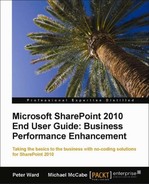When you talk about governance, an end user might think of IT governance, but here it is about a user's governance to his information.
What does this mean? Part of the problem with network drives and e-mails is that they become a dumping ground for information that no one is responsible for. In turn, this information is unsearchable and no one has ownership over it.
This information experience should be avoided at all costs. Consider the following six questions:
- Can the information be metatagged? If SharePoint's taxonomies feature can be used, locating information will be quicker and easier for you.
- Who is the owner of this information? Department or individual.
- Should I have an archiving policy on the information, to a location that I can easily access, but which is not on my immediate home page? SharePoint has Information Policies that can be assigned to documents.
- Does the information require approval by anyone?
- Notification of new/changed information. How should I set this up for my team and myself?
- Who needs access to this information? Co-workers/external parties.
When the preceding questions can be answered or addressed, the value of documents and information is dramatically increased because it is more relevant to an organization, it is more likely to be correct, and there is an owner assigned to it who can be accountable for any action.
With SharePoint, there is an element of front loading the information, which will be based on technical considerations such as how often the information is being reviewed or requested.
